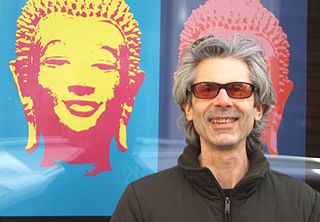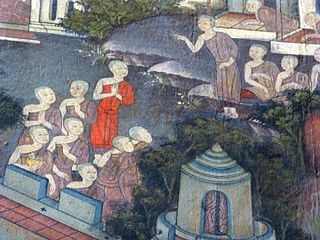The purpose of this timeline is to give a detailed account of Buddhism from the birth of Gautama Buddha to the present.
Satori (悟り) is a Japanese Buddhist term for awakening, "comprehension; understanding". It is derived from the Japanese verb satoru.

Jōdo Shinshū, also known as Shin Buddhism or True Pure Land Buddhism, is a school of Pure Land Buddhism. It was founded by the former Tendai Japanese monk Shinran.

Buddhism has been practiced in Japan since about the 6th century CE. Japanese Buddhism created many new Buddhist schools, and some schools are original to Japan and some are derived from Chinese Buddhist schools. Japanese Buddhism has had a major influence on Japanese society and culture and remains an influential aspect to this day.
Engaged Buddhism, also known as socially engaged Buddhism, refers to a Buddhist social movement that emerged in Asia in the 20th century, composed of Buddhists who are seeking ways to apply the Buddhist ethics, insights acquired from meditation practice, and the teachings of the Buddhist dharma to contemporary situations of social, political, environmental and economic suffering, and injustice. Finding its roots in Vietnam through the Thiền Buddhist teacher Thích Nhất Hạnh, Engaged Buddhism was popularised by the Indian jurist, politician, and social reformer B. R. Ambedkar who inspired the Dalit Buddhist movement in the 1950s, and has since grown by spreading to the Indian subcontinent and the West.

Mark Epstein is an American author and psychotherapist who integrates Shakyamuni Buddha's teachings with Sigmund Freud's approaches to trauma. He often writes about the interface of Buddhism and psychotherapy.
A Buddhist chant is a form of musical verse or incantation, in some ways analogous to religious recitations of other faiths.

John Hurrell Crook was a British ethologist who filled a pivotal role in British primatology.
Masao Abe was a Japanese Buddhist philosopher and religious studies scholar who was emeritus professor at Nara University. He is best known for his work in comparative religion, developing a Buddhist-Christian interfaith dialogue which later also included Judaism. His mature views were developed within the Kyoto School of philosophy. According to Christopher Ives: "Since the death of D. T. Suzuki in 1966, Masao Abe has served as the main representative of Zen Buddhism in Europe and North America."

Buddhism and Jainism are two Indian religions that developed in Magadha (Bihar) and continue to thrive in the modern age. Gautama Buddha and Mahavira are generally accepted as contemporaries. Jainism and Buddhism share many features, terminology and ethical principles, but emphasize them differently. Both are śramaṇa ascetic traditions that believe it is possible to attain liberation from the cycle of rebirths and deaths (samsara) through spiritual and ethical disciplines. They differ in some core doctrines such as those on asceticism, Middle Way versus Anekantavada, and self versus not-self.

Kyudo Nakagawa, or Nakagawa Kyūdō, was a Japanese-born Rinzai rōshi who for many years led Soho Zen Buddhist Society, Inc. in Manhattan's Lower East Side.

Women in Buddhism is a topic that can be approached from varied perspectives including those of theology, history, anthropology, and feminism. Topical interests include the theological status of women, the treatment of women in Buddhist societies at home and in public, the history of women in Buddhism, and a comparison of the experiences of women across different forms of Buddhism. As in other religions, the experiences of Buddhist women have varied considerably.
Alfred Bloom was a pioneer of Jōdo Shinshū studies in the English-speaking world.

Buddhism includes an analysis of human psychology, emotion, cognition, behavior and motivation along with therapeutic practices. Buddhist psychology is embedded within the greater Buddhist ethical and philosophical system, and its psychological terminology is colored by ethical overtones. Buddhist psychology has two therapeutic goals: the healthy and virtuous life of a householder and the ultimate goal of nirvana, the total cessation of dissatisfaction and suffering (dukkha).
Eastern philosophy in clinical psychology refers to the influence of Eastern philosophies on the practice of clinical psychology based on the idea that East and West are false dichotomies. Travel and trade along the Silk Road brought ancient texts and mind practices deep into the West. Vedic psychology dates back 5000 years and forms the core of mental health counselling in the Ayurvedic medical tradition. The knowledge that enlightened Siddhartha Gautama was the self-management of mental suffering through mindfulness awareness practices. Humane interpersonal care of the mentally disturbed was practiced in the Middle East in the Middle Ages, and later in the West. Many of the founders of clinical psychology were influenced by these ancient texts as translations began to reach Europe during the 19th century.

In Buddhism, faith refers to a serene commitment to the practice of the Buddha's teaching and trust in enlightened or highly developed beings, such as Buddhas or bodhisattvas. Buddhists usually recognize multiple objects of faith, but many are especially devoted to one in particular, such as one particular Buddha. Faith may not only be devotion to a person, but exists in relation to Buddhist concepts like the efficacy of karma and the possibility of enlightenment.

Buddhism played an important role in the development of Japanese art between the 6th and the 16th centuries. Buddhist art and Buddhist religious thought came to Japan from China through Korea. Buddhist art was encouraged by Crown Prince Shōtoku in the Suiko period in the sixth century, and by Emperor Shōmu in the Nara period in the eighth century. In the early Heian period, Buddhist art and architecture greatly influenced the traditional Shinto arts, and Buddhist painting became fashionable among wealthy Japanese. The Kamakura period saw a flowering of Japanese Buddhist sculpture, whose origins are in the works of Heian period sculptor Jōchō. During this period, outstanding busshi appeared one after another in the Kei school, and Unkei, Kaikei, and Tankei were especially famous. The Amida sect of Buddhism provided the basis for many popular artworks. Buddhist art became popular among the masses via scroll paintings, paintings used in worship and paintings of Buddhas, saint's lives, hells and other religious themes. Under the Zen sect of Buddhism, portraiture of priests such as Bodhidharma became popular as well as scroll calligraphy and sumi-e brush painting.

Manju-ji (万寿寺) is a Rinzai Buddhist temple in Higashiyama-ku Kyoto, Japan. Owing to the influence of the Ashikaga, Manju-ji was designated a Jissatsu temple for a time. At present, it is a sub-temple of Tōfuku-ji. It is considered to be one of the so-called Kyoto Gozan or "five great Zen temples of Kyoto".
Buddhist modernism are new movements based on modern era reinterpretations of Buddhism. David McMahan states that modernism in Buddhism is similar to those found in other religions. The sources of influences have variously been an engagement of Buddhist communities and teachers with the new cultures and methodologies such as "Western monotheism; rationalism and scientific naturalism; and Romantic expressivism". The influence of monotheism has been the internalization of Buddhist gods to make it acceptable in modern Western society, while scientific naturalism and romanticism has influenced the emphasis on current life, empirical defense, reason, psychological and health benefits.
Other-centred therapy is a particular approach used in psychotherapy and other therapeutic fields which is grounded in Buddhist psychology principles. the approach addresses the relationship between the self and the world through an investigation of perception; its conditioned nature and the possibility for change.











